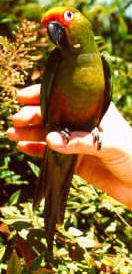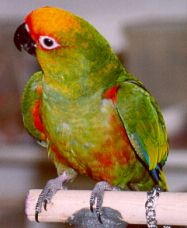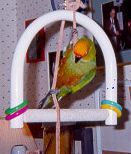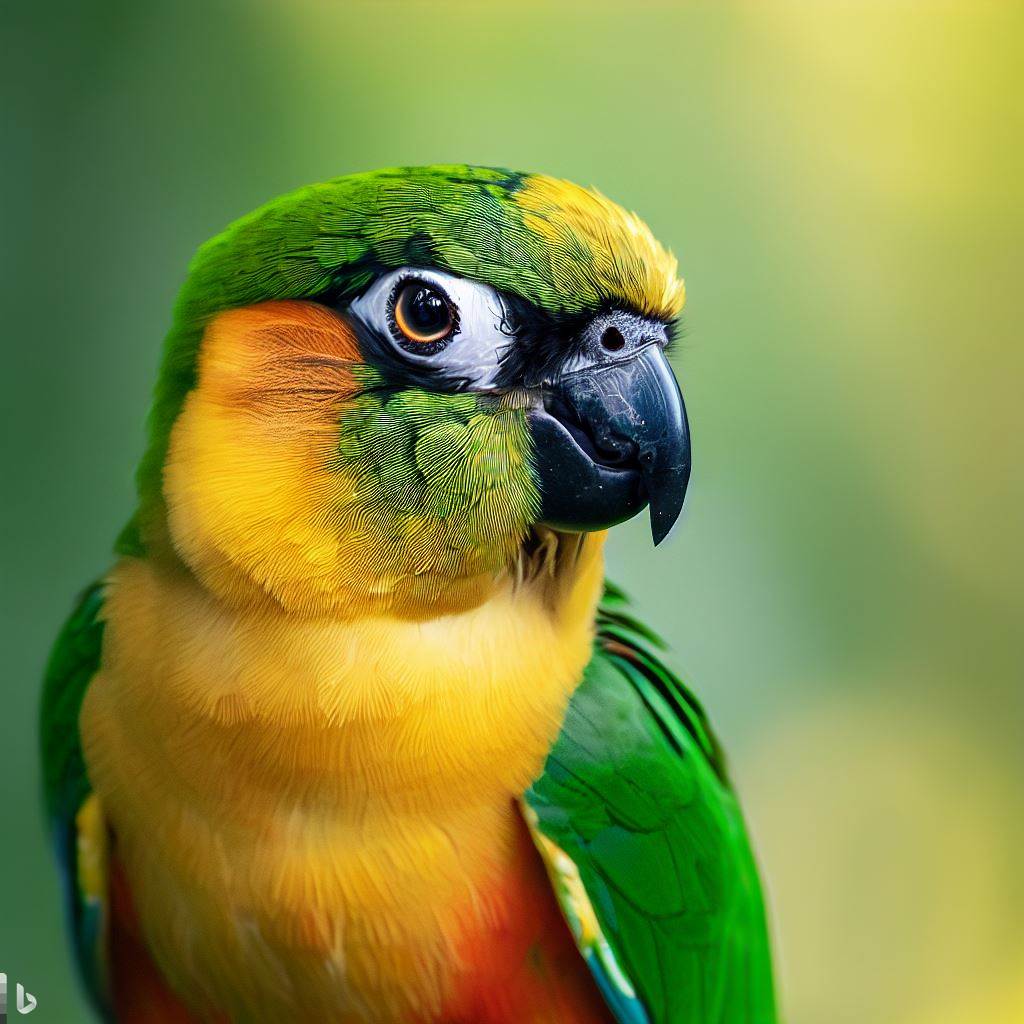When Sam and I bought Ariel, our golden-capped conure, Sam already had a bird, I already had a bird, and we had promised ourselves (and our children) that we were not getting any more birds. Additionally, I had privately resolved that if we ever did get another bird, it was certainly not going to be one of those noisy little conures. The two birds we already had (an eclectus and a senegal) are relatively quiet creatures, and I had no desire to have my eardrums broken.

Sold!
I tell this as a cautionary tale. It does not matter how sure you are you do not want a conure, once you are foolish enough to pick one up, the odds are you are going home with it. That’s the bad news. The good news is that once you give in and take your conure home, you will never regret it. Ariel is the family darling, the apple of our eyes, and the cutest bird in the entire world. Our kids, whose attitudes toward our first two birds range from baffled to annoyed (why can’t their folks just have cats and dogs like everyone else?) adore the little creature.

Like its cousins the suns and the jendays, golden-capped conures do not have their full coloring as infants. A very young golden-capped is essentially a little green bird with a long tail. Some orange shows around the eyes, above the beak, and on the breast near the wings, and some navy is mixed in with the green of the tail, but the bird’s full beauty is not apparent until after the first molt. As the new feathers come in, the golden cap appears, along with a sprinkling of gold extending down to the shoulders. A golden-capped with its mature coloring looks like it’s perpetually caught in a sunbeam.

So, is there a downside to these adorable creatures? Membership on the conure e-mail list reveals two problems that surface repeatedly: (1) Help! My conure won’t stop shrieking! and (2) Help! My conure won’t stop nipping! These flaws seem to afflict all conures to some degree, and the golden-capped is not immune. The good news is that these problems can be managed.
Golden-capped are not quite as loud as suns and jendays, but this distinction will seem minor when your ears are ringing. Some conure-shrieking seems to be unavoidable. A conure is going to shriek when you first come into the house (in the rainforests, this would be the way the flock greets returning members). It is also going to shriek when alarmed (again, this is an instinctive way of warning the flock of possible danger). These shrieks should not be ignored or punished. When I come home, I always say hello and fuss over Ariel; this seems to keep the duration of the flock greeting down. An alarmed shriek needs immediate, soothing attention. Once the fright is over, the shrieking stops.
On the other hand, too much attention, positive or negative, paid to a conure who shrieks (other than as an alarm or a flock-greeting), can lead to a bird that’s almost intolerably noisy. Conures can be trained to be left alone for large blocks of time while their owners get other things done; however, they would much rather be with their owners, and will do their best to train their owners to give them as much time and attention as possible. If you respond to a shrieking conure, either by scolding or by picking it up, the bird will perceive your response as success. In no time, your conure will be shrieking anytime it wants a little face-to-face with you. The best policy by far seems to be to ignore a shrieking conure (as long as it is in no trouble), and go on about your business. Then, when things are quiet, take the opportunity to go and fuss over it when it’s being good. These birds are not dumb. They quickly learn that good, quiet little conures get more attention than noisy ones.
Nippiness, if handled properly, should not be more than a stage a conure goes through. Generally, all young conures want to be chewing on something at all times. Unfortunately, if your finger happens to be handy, the conure will chew on that — and those little beaks are deceptively strong and sharp. We have found distraction to be the best method of dealing with this. First, we pry the beak off the part of our anatomy to which it is attached (remembering not to scream or cuss, because conures love drama). Then we grab something the bird is allowed to chew on, like a popsicle stick or a chew toy, and hand it to the conure. Repeatedly rejecting the stick in favor of the finger is punishable by returning the conure to its cage — and, again, conures are clever enough to figure this out fairly quickly. During Ariel’s nippy stage, we kept cups of popsicle sticks, some dyed and flavored with unsweetened Kool-Aid, all over the house so that we were never out of arm’s reach of something for him to chew on. Nippiness, it should be remembered, may recur with sexual maturity, molting, or fatigue, or any other situation that causes stress, so it is probably wise not to throw those chew toys away at the first sign of improvement. Again, however, with proper handling, the problem should not be insurmountable.
Like all psittacines, golden-capped conures have benefited enormously from the recent advances in avian diet and health care. With proper nutrition, housing, hygiene, and veterinary attention, a golden-capped conure may be expected to live thirty years. For the sake of their health and well being, golden-capped conures need to be fed a balanced diet. Unless you want to make a full-time job of preparing meals for your bird, the simplest way to do this is to go with a diet that consists primarily of pellets from one of the reputable manufacturers. This pelleted diet should be supplemented by a wide variety of fresh vegetables, and a lesser amount of fresh fruits. Healthy table foods like pasta, cooked beans, oatmeal, and cooked rice should also be added. (There are a number of commercial mixes on the market for birds, but there is no reason not to make your own if you prefer.) Seeds and nuts should be kept to a minimum — their fat content is too high for them to be a large part of a healthy diet for your bird. And chocolate and avocados should never be fed, as they contain substances that can be lethal to birds.
All psittacines need to be housed in cages that are large enough for the bird to be able to fully spread its wings. Fortunately, in the case of golden-capped conures, this does not mean a very big cage. Ariel lives quite happily in a cage that measures 18″ x 18″ x 36″. Bar-spacing needs to be examined carefully so that there is no danger that the bird can get its head through the bars. All conures need to have their cages stocked with a wide variety of safety-tested toys to occupy them happily when they can’t be interacting with their owners. A Happy Hut or similar fabric tube in the cage provides a conure with a safe place to snuggle when you’re not around. Ariel sleeps in his, and loves to dry off in it after his shower. Cages need to be kept clean; conures touch every surface available with their tongues, and a dirty cage can quickly lead to an infection. The liner in the cage bottom needs to be one that will not harbor mold or bacteria. Many of the commercial litters, including corn cobs and walnut shells, are actually dangerous, especially if the bird can reach and ingest it. We have found newspaper an excellent choice, both for health and economic reasons.
Golden-capped conures need frequent baths to keep their feathers in good condition. A daily shower or bath helps keep feather casings soft enough to shed easily, and prevents many of the problems associated with dry skin. It also keeps the conure looking wonderful. Some conures prefer bathing in their water dishes; in that case, the dish needs to be cleaned frequently to avoid bacterial problems. Ariel is misted daily with a plant mister — a process he enjoys now, although at first it frightened him. If your bird fears bathing, you need to gently persist until you find a method it will tolerate (and will probably even learn to enjoy).
Any new bird brought into your home needs an initial visit to the vet (preferably a vet with avian experience) within the first forty-eight hours. If you have other birds, a quarantine should be arranged so that no diseases will be transmitted from the newcomer to the current flock. All birds need to visit the vet for a wellness check at least annually, and a sick bird needs to be taken to the vet immediately. Conures (and other parrots) are particularly adept at hiding illnesses, and by the time symptoms are visible, a disease may be quite advanced.
There is another hazard to which conures are particularly susceptible, and which their owners (and potential owners) should be award of. Because of their relatively narrow bodies and the lift they get from their long tails, a conure may be able to fly quite well even with clipped wings. I have heard and read too many heart-breaking stories of conures who were taken outside, caught a breeze, and never came home again. Some of these birds had been with their owners for many years, had been taken outside since babyhood, and still one day unexpectedly took flight. For this reason, I no longer let Ariel outside unrestrained. There are a number of harnesses on the market that many conure owners use successfully; for everyone’s sake, I believe an unharnessed conure should be outside only in a carrier.
Golden-capped conures make good first birds, although any child needs supervision with any psittacine. They are relatively inexpensive, don’t take up a lot of room, and are resourceful enough to entertain themselves while their owners are at work or school. Their noisiness is a factor to consider in an apartment environment, but generally should not be a problem if handled correctly. And their playfulness, intelligence, and good dispositions make them completely irresistible companions.
If you don’t believe me, take a trip to your local bird store to meet one. Go ahead! I dare you.
Just don’t blame me if you take it home.

